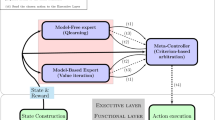Abstract
Good initializations are always beneficial for efficiently training neural networks. In this study, we propose a method for initializing a layered neural network with common-sensical human knowledge in an intuitive manner. To make this idea possible, a hierarchical neural network containing a two-dimensional topological map is adopted as an adaptive controller for physical robots. The low dimensionality of the map allows humans to hand-design the topological structure to infuse human common-sensical knowledge. The prior knowledge initialization subsequently allows the robot to execute efficient reinforcement learning in a real environment. The primary novelty of this study is the idea for transferring human common-sensical knowledge that may be subjective and not necessarily logically or mathematically expressible. While transfer learning between two different neural networks is common, transfer learning from human to neural networks is not sufficiently studied, and hence, this study offers a new idea for collaborative learning between human and neural networks. The idea is tested in the context of the real-time reinforcement learning of real robots.












Similar content being viewed by others
References
Adadi A, Berrada M (2018) Peeking inside the black-box: a survey on explainable artificial intelligence (xai). IEEE Access 6:52138–52160. https://doi.org/10.1109/ACCESS.2018.2870052
Deng J, Dong W, Socher R, Li LJ, Li K, Fei-Fei L (2009) Imagenet: a large-scale hierarchical image database. In: 2009 IEEE conference on computer vision and pattern recognition, pp 248–255. https://doi.org/10.1109/CVPR.2009.5206848
Hartono P (2020) Mixing autoencoder with classifier: conceptual data visualization. IEEE Access 8:105,301-105,310. https://doi.org/10.1109/ACCESS.2020.2999155
Hartono P, Hollensen P, Trappenberg T (2015) Learning-regulated context relevant topographical map. IEEE Trans Neural Netw Learn Syst 26(10):2323–2335. https://doi.org/10.1109/TNNLS.2014.2379275
Hartono P, Kakita S (2009) Fast reinforcement learning for simple physical robots. Memetic Comput 1(4):305–313. https://doi.org/10.1007/s12293-009-0015-x
Hwangbo J et al (2019) Learning agile and dynamic motor skills for legged robots. Sci Robot 4(26):eaau5872. https://doi.org/10.1126/scirobotics.aau5872
Koh PW, Liang P (2017) Understanding black-box predictions via influence functions. In: Precup D, Teh YW (eds) Proceedings of the 34th international conference on machine learning. Proceedings of machine learning research, vol 70. PMLR, pp 1885–1894. https://proceedings.mlr.press/v70/koh17a.html
Kohonen T (1982) Self-organized formation of topologically correct feature maps. Biol Cybern 43:59–69. https://doi.org/10.1007/BF00337288
LeCun Y et al (2015) Deep learning. Nature 521:436–444. https://doi.org/10.1038/nature14539
Mikolov T, Sutskever I, Chen K, Corrado G, Dean J (2013) Distributed representations of words and phrases and their compositionality. In: Proceedings of the 26th international conference on neural information processing systems, vol 2. NIPS’13, pp 3111-3119
Mnih V et al (2015) Human-level control through deep reinforcement learning. Nature 518:529–533. https://doi.org/10.1038/nature14236
Peng XB, Andrychowicz M, Zaremba W, Abbeel P (2018) Sim-to-real transfer of robotic control with dynamics randomization. In: 2018 IEEE international conference on robotics and automation (ICRA), pp 3803–3810. https://doi.org/10.1109/ICRA.2018.8460528
Peng XB et al (2020) Learning agile robotic locomotion skills by imitating animals. https://arxiv.org/abs/2004.00784
Redmon J, Divvala S, Girshick R, Farhadi A (2016) You only look once: Unified, real-time object detection. In: 2016 IEEE conference on computer vision and pattern recognition (CVPR). IEEE Computer Society, pp 779–788. https://doi.org/10.1109/CVPR.2016.91
Rumelhart D, Hinton G, Williams RJ (1986) Learning representations by back-propagating errors. Nature 323:533–536. https://doi.org/10.1038/323533a0
Sabol P et al (2020) Explainable classifier for improving the accountability in decision-making for colorectal cancer diagnosis from histopathological images. J Biomed Inf 109:103–523. https://doi.org/10.1016/j.jbi.2020.103523
Selvaraju RR, Cogswell M, Das A, Vedantam R, Parikh D, Batra D (2017) Grad-cam: visual explanations from deep networks via gradient-based localization. In: 2017 IEEE international conference on computer vision (ICCV), pp 618–626. https://doi.org/10.1109/ICCV.2017.74
Silver D et al (2017) Mastering the game of go without human knowledge. Nature 550:354–358. https://doi.org/10.1038/nature24270
Silver D et al (2018) A general reinforcement learning algorithm that masters chess, shogi, and go through self-play. Science 362(6419):1140–1144. https://doi.org/10.1126/science.aar6404
Sundararajan M, Taly A, Yan Q (2017) Axiomatic attribution for deep networks. In: Proceedings of the 34th international conference on machine learningm, vol 70. ICML’17, pp 3319-3328
Tan C et al (2018) A survey on deep transfer learning. In: Kůrková V, Manolopoulos Y, Hammer B, Iliadis L, Maglogiannis I (eds) Artificial neural networks and machine learning–ICANN 2018. Springer International Publishing, New York, pp 270–279
Tan J, Zhang T, Coumans E, Iscen A, Bai Y, Hafner D, Bohez S, Vanhoucke V (2018) Sim-to-real: Learning agile locomotion for quadruped robots. In: Proceedings of robotics: science and systems. https://doi.org/10.15607/RSS.2018.XIV.010.https://arxiv.org/pdf/1804.10332.pdf
Weiss K et al (2016) A survey of transfer learning. J Big Data 3(9). https://doi.org/10.1186/s40537-016-0043-6
Xie Z, Clary P, Dao J, Morais P, Hurst J, van de Panne M (2020) Learning locomotion skills for Cassie: iterative design and sim-to-real. In: Kaelbling LP, Kragic D, Sugiura K (eds) Proceedings of the conference on robot learning. Proceedings of machine learning research, vol 100, pp 317–329
Yu W, Kumar VC, Turk G, Liu CK (2019) Sim-to-real transfer for biped locomotion .https://doi.org/10.48550/ARXIV.1903.01390.https://arxiv.org/abs/1903.01390
Zeng A et al. (2018) Learning synergies between pushing and grasping with self-supervised deep reinforcement learning. In: 2018 IEEE/RSJ international conference on intelligent robots and systems (IROS), pp 4238–4245 .https://doi.org/10.1109/IROS.2018.8593986
Author information
Authors and Affiliations
Corresponding author
Additional information
Publisher's Note
Springer Nature remains neutral with regard to jurisdictional claims in published maps and institutional affiliations.
About this article
Cite this article
Ogawa, K., Hartono, P. Infusing common-sensical prior knowledge into topological representations of learning robots. Artif Life Robotics 27, 576–585 (2022). https://doi.org/10.1007/s10015-022-00776-5
Received:
Accepted:
Published:
Issue Date:
DOI: https://doi.org/10.1007/s10015-022-00776-5




